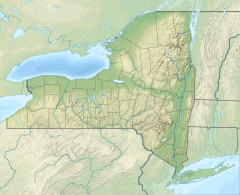| West Kill | |
|---|---|
 West Kill from Shoemaker Road | |
| Location | |
| Country | United States |
| State | New York |
| Region | Catskills |
| County | Greene |
| Towns | Hunter, Lexington |
| Physical characteristics | |
| Source | W slope of Hunter Mountain |
| • coordinates | 42°10′24″N 74°14′15″W / 42.17333°N 74.23750°W[1] |
| • elevation | 3,100 ft (940 m) |
| Mouth | Schoharie Creek |
• location | Lexington, New York |
• coordinates | 42°14′45″N 74°22′36″W / 42.24583°N 74.37667°W[1] |
• elevation | 1,299 ft (396 m) |
| Length | 11 mi (18 km), E-W |
| Basin size | 31.2 sq mi (81 km2) |
| Discharge | |
| • location | E of Spruceton |
| • average | 10.1 cu ft/s (0.29 m3/s) |
| • minimum | .45 cu ft/s (0.013 m3/s) |
| • maximum | 4,320 cu ft/s (122 m3/s) |
| Discharge | |
| • location | N of West Kill |
| • average | 41.7 cu ft/s (1.18 m3/s) |
| • minimum | 1.3 cu ft/s (0.037 m3/s) |
| • maximum | 19,100 cu ft/s (540 m3/s) |
| Basin features | |
| Progression | West Kill → Schoharie Creek → Mohawk River → Hudson River → Upper New York Bay |
| Tributaries | |
| • left | Pettit Brook, Styles Brook, Hagadone Brook, Bennett Brook, Newton Brook, Beech Ridge Brook, Roarback Brook |
| • right | Hunter Brook, Herdman Brook, Schoolhouse Brook |
| Waterfalls | Diamond Notch Falls |
The West Kill, an 11-mile-long (18 km)[2] tributary of Schoharie Creek, flows through the town of Lexington, New York, United States, from its source on Hunter Mountain, the second-highest peak of the Catskill Mountains.[3] Ultimately its waters reach the Hudson River via the Mohawk. Since it drains into the Schoharie upstream of Schoharie Reservoir, it is part of the New York City water supply system. It lends its name to both a mountain to its south and a small town midway along its length.
The West Kill's 31.2-square-mile (81 km2)[4] watershed accounts for 10 percent of the reservoir's basin. It has the highest elevations[5] and steepest slopes[6] of any of the Schoharie's subwatersheds, with runoff from seven of the 35 Catskill High Peaks draining into the stream. Due to limited development and extensive land protection in the stream's watershed, its water is relatively clean, supporting a habitat for both wild and stocked trout; historically it has drawn fly fishers and other anglers. However, the West Kill has contributed to turbidity issues with the Schoharie creek and reservoir due to recent floods; several government agencies have worked together to develop a management plan that will mitigate the floods and the turbidity.
- ^ a b "West Kill". Geographic Names Information System. United States Geological Survey, United States Department of the Interior. Retrieved 2018-01-09.
- ^ "Public Fishing Rights Maps – West Kill" (PDF). New York State Department of Environmental Conservation. Retrieved January 7, 2018.
- ^ "West Kill". U.S. Geological Survey. Retrieved April 23, 2017.
- ^ "Hydrology and Flood History" (PDF). Catskill Streams. Retrieved January 7, 2018.
- ^ "Geology of the West Kill Watershed" (PDF). Catskill Streams. p. 4. Retrieved January 8, 2018.
- ^ "2.2 Physiography" (PDF). Catskill Streams. Retrieved January 8, 2018.

